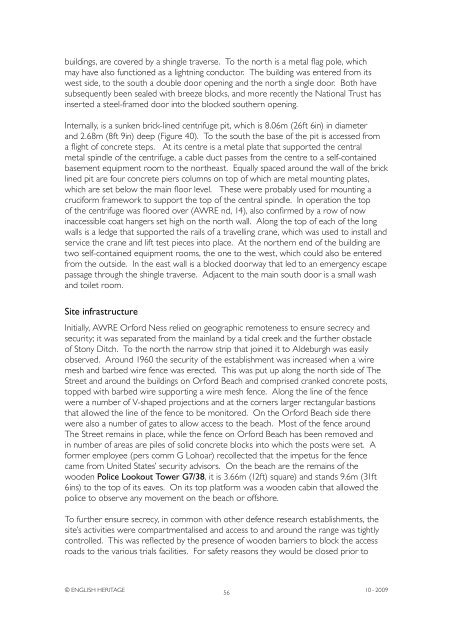Atomic Weapons Research Establishment. Orford ... - English Heritage
Atomic Weapons Research Establishment. Orford ... - English Heritage
Atomic Weapons Research Establishment. Orford ... - English Heritage
Create successful ePaper yourself
Turn your PDF publications into a flip-book with our unique Google optimized e-Paper software.
uildings, are covered by a shingle traverse. To the north is a metal flag pole, which<br />
may have also functioned as a lightning conductor. The building was entered from its<br />
west side, to the south a double door opening and the north a single door. Both have<br />
subsequently been sealed with breeze blocks, and more recently the National Trust has<br />
inserted a steel-framed door into the blocked southern opening.<br />
Internally, is a sunken brick-lined centrifuge pit, which is 8.06m (26ft 6in) in diameter<br />
and 2.68m (8ft 9in) deep (Figure 40). To the south the base of the pit is accessed from<br />
a flight of concrete steps. At its centre is a metal plate that supported the central<br />
metal spindle of the centrifuge, a cable duct passes from the centre to a self-contained<br />
basement equipment room to the northeast. Equally spaced around the wall of the brick<br />
lined pit are four concrete piers columns on top of which are metal mounting plates,<br />
which are set below the main floor level. These were probably used for mounting a<br />
cruciform framework to support the top of the central spindle. In operation the top<br />
of the centrifuge was floored over (AWRE nd, 14), also confirmed by a row of now<br />
inaccessible coat hangers set high on the north wall. Along the top of each of the long<br />
walls is a ledge that supported the rails of a travelling crane, which was used to install and<br />
service the crane and lift test pieces into place. At the northern end of the building are<br />
two self-contained equipment rooms, the one to the west, which could also be entered<br />
from the outside. In the east wall is a blocked doorway that led to an emergency escape<br />
passage through the shingle traverse. Adjacent to the main south door is a small wash<br />
and toilet room.<br />
Site infrastructure<br />
Initially, AWRE <strong>Orford</strong> Ness relied on geographic remoteness to ensure secrecy and<br />
security; it was separated from the mainland by a tidal creek and the further obstacle<br />
of Stony Ditch. To the north the narrow strip that joined it to Aldeburgh was easily<br />
observed. Around 1960 the security of the establishment was increased when a wire<br />
mesh and barbed wire fence was erected. This was put up along the north side of The<br />
Street and around the buildings on <strong>Orford</strong> Beach and comprised cranked concrete posts,<br />
topped with barbed wire supporting a wire mesh fence. Along the line of the fence<br />
were a number of V-shaped projections and at the corners larger rectangular bastions<br />
that allowed the line of the fence to be monitored. On the <strong>Orford</strong> Beach side there<br />
were also a number of gates to allow access to the beach. Most of the fence around<br />
The Street remains in place, while the fence on <strong>Orford</strong> Beach has been removed and<br />
in number of areas are piles of solid concrete blocks into which the posts were set. A<br />
former employee (pers comm G Lohoar) recollected that the impetus for the fence<br />
came from United States’ security advisors. On the beach are the remains of the<br />
wooden Police Lookout Tower G7/38, it is 3.66m (12ft) square) and stands 9.6m (31ft<br />
6ins) to the top of its eaves. On its top platform was a wooden cabin that allowed the<br />
police to observe any movement on the beach or offshore.<br />
To further ensure secrecy, in common with other defence research establishments, the<br />
site’s activities were compartmentalised and access to and around the range was tightly<br />
controlled. This was reflected by the presence of wooden barriers to block the access<br />
roads to the various trials facilities. For safety reasons they would be closed prior to<br />
© ENGLISH HERITAGE<br />
56<br />
10 - 2009

















